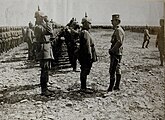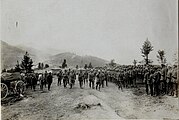The 1st Royal Bavarian Division was a unit of the Royal Bavarian Army that served alongside the Prussian Army as part of the Imperial German Army. The division was formed on November 27, 1815, as the Infantry Division of the Munich General Command. It was called the 1st Army Division between 1822 and 1848, again between 1851 and 1859, and again from 1869 to 1872. It was called the 1st Infantry Division from 1848 to 1851 and was named the Munich General Command from 1859 to 1869. From April 1, 1872, until mobilization for World War I, it was the 1st Division. Within Bavaria, it was not generally referred to as a "Royal Bavarian" division, but outside Bavaria, this designation was used for it, and other Bavarian units, to distinguish them from similarly numbered Prussian units. The division was headquartered in Munich from 1815 to 1919. The division was part of the 1st Royal Bavarian Army Corps.
The 30th Royal Bavarian Reserve Division was a reserve infantry division of the Imperial German Army in World War I. It was initially the Main Reserve, Fortress Strasbourg and was designated the 30th Reserve Division from mobilization in August 1914. It was almost entirely made up of Bavarian units and thus, on December 26, 1916, it was renamed the 30th Royal Bavarian Reserve Division. It spent the war engaged in positional warfare in the Vosges mountains of France and the Alsace-Lorraine region.
The 39th Royal Bavarian Reserve Division was a reserve infantry division of the Imperial German Army in World War I. It was raised to division status on October 2, 1914, from an ad hoc unit, "Brigade von Rekowski", and named "Division von Rekowski". On December 8, 1914, it was renamed the 39th Reserve Division. As it was heavily made up of Bavarian units, on December 26, 1916, it was again renamed, this time as the 39th Royal Bavarian Reserve Division. It spent the war engaged in positional warfare in the Alsace-Lorraine region. It was dissolved in 1919 during the demobilization of the German Army after the Armistice.
The Bavarian Ersatz Division was a Bavarian division of the Imperial German Army in World War I. It was formed in August 1914 and dissolved on 6 October 1918. It was initially a Bavarian formation but soon received several non-Bavarian units which served with the division until 1917.
The 6th Bavarian Reserve Division was a unit of the Royal Bavarian Army, part of the German Army, in World War I. The division was formed on 10 September 1914 and organized over the next month. The division was disbanded in 1919 during the demobilization of the German Army after World War I.
The 5th Bavarian Reserve Division was a unit of the Royal Bavarian Army, part of the German Army, in World War I. The division was formed on mobilization of the German Army in August 1914 as part of I Royal Bavarian Reserve Corps. The division was disbanded in 1919 during the demobilization of the German Army after World War I. The division was raised and recruited in Bavaria, mainly in Upper Bavaria and Upper and Middle Franconia. As a reserve division, it included many recalled reservists.
The 1st Bavarian Reserve Division was a unit of the Royal Bavarian Army, part of the German Army, in World War I. The division was formed on mobilization of the German Army in August 1914 as part of I Royal Bavarian Reserve Corps. The division was disbanded in 1919 during the demobilization of the German Army after World War I. The division was raised and recruited in Bavaria. As a reserve division, it included many recalled reservists and war volunteers.
The 33rd Reserve Division was a unit of the Imperial German Army, in World War I. The division was formed on the mobilization of the German Army in August 1914. The division was disbanded in August 1918. The division began the war as part of the central reserve of Fortress Metz.
The 8th Bavarian Reserve Division was a unit of the Imperial German Army in World War I. The division was formed at the end of December 1914 and organized over the next month, arriving in the line in late January 1915. It was part of the second large wave of new divisions formed at the outset of World War I. The division was disbanded in 1919, during the demobilization of the German Army after World War I. The division was recruited in the Kingdom of Bavaria and was considered to be skilled in mountain warfare.
The 9th Bavarian Reserve Division was a unit of the Imperial German Army in World War I. The division was formed on September 26, 1916, and entered the line in October. It was a Bavarian unit and was part of a large wave of new divisions formed in the summer and autumn of 1916. It was disbanded in June 1918 and its assets distributed to other units.
The 2nd Royal Bavarian Division was a unit of the Royal Bavarian Army which served alongside the Prussian Army as part of the Imperial German Army. The division was formed on November 27, 1815, as the Infantry Division of the Munich General Command. It was called the 2nd Army Division between 1822 and 1848, again between 1851 and 1859, and again from 1869 to 1872. It was called the 2nd Infantry Division from 1848 to 1851 and was named the Augsburg General Command from 1859 to 1869. From April 1, 1872, until mobilization for World War I, it was the 2nd Division. In Bavarian sources, it was not generally referred to as a "Royal Bavarian" division, as this was considered self-evident, but outside Bavaria, this designation was used for it, and other Bavarian units, to distinguish them from similarly numbered Prussian units. The division was headquartered in Ingolstadt from 1815 to 1817, in Regensburg from 1817 to 1822, and in Augsburg from 1822 to 1919, except for the period 1871-1873, when it was part of the German occupation forces in France. The division was part of the I Royal Bavarian Army Corps.
The 3rd Royal Bavarian Division was a unit of the Royal Bavarian Army which served alongside the Prussian Army as part of the Imperial German Army. The division was formed on November 27, 1815, as an Infantry Division of the Würzburg General Command. It was called the 3rd Army Division between 1822 and 1848, again between 1851 and 1859, and again from 1869 to 1872. It was called the 3rd Infantry Division from 1848 to 1851 and was named the Nuremberg General Command from 1859 to 1869. From April 1, 1872, until mobilization for World War I, it was the 3rd Division. In 1901, it had swapped division numbers with the 5th Division. In Bavarian sources, it was not generally referred to as a "Royal Bavarian" division, as this was considered self-evident, but outside Bavaria, this designation was used for it, and other Bavarian units, to distinguish them from similarly numbered Prussian units. The division was headquartered in Nuremberg from 1815 to 1843, in Ansbach from 1843 to 1848, and then again in Nuremberg until 1901, when after the renumbering of divisions, it became the 3rd Division in Landau and the division in Nuremberg became the 5th Division. The division was part of the II Royal Bavarian Army Corps.
The 4th Royal Bavarian Division was a unit of the Royal Bavarian Army which served alongside the Prussian Army as part of the Imperial German Army. The division was formed on November 27, 1815, as an Infantry Division of the Würzburg General Command. It was called the 4th Army Division between 1822 and 1848, again between 1851 and 1859, and again from 1869 to 1872. It was called the 4th Infantry Division from 1848 to 1851 and was named the Würzburg General Command from 1859 to 1869. From April 1, 1872, until mobilization for World War I, it was the 4th Division. In Bavarian sources, it was not generally referred to as a "Royal Bavarian" division, as this was considered self-evident, but outside Bavaria, this designation was used for it, and other Bavarian units, to distinguish them from similarly numbered Prussian units. The division was headquartered in Würzburg. The division was part of the II Royal Bavarian Army Corps.
The 5th Royal Bavarian Division was a unit of the Royal Bavarian Army which served alongside the Prussian Army as part of the Imperial German Army. The division was formed on October 1, 1890, in Landau as the 5th Division and swapped division numbers with the Nuremberg-based 3rd Royal Bavarian Division in 1901. In Bavarian sources, it was not generally referred to as a "Royal Bavarian" division, as this was considered self-evident, but outside Bavaria, this designation was used for it, and other Bavarian units, to distinguish them from similarly numbered Prussian units. The division was part of the III Royal Bavarian Army Corps.
The 6th Royal Bavarian Division was a unit of the Royal Bavarian Army which served within the Imperial German Army. The division was formed on April 1, 1900, and was headquartered in Regensburg. In Bavarian sources, it was not generally referred to as a "Royal Bavarian" division, as this was considered self-evident, but outside Bavaria, this designation was used for it, and other Bavarian units, to distinguish them from similarly numbered Prussian units. The division was part of the III Royal Bavarian Army Corps.
The 11th Bavarian Infantry Division was a unit of the Royal Bavarian Army, part of the Imperial German Army, in World War I. The division was formed on March 24, 1915, and organized over the next few weeks. It was part of a wave of new infantry divisions formed in the spring of 1915. The division was disbanded in 1919 during the demobilization of the German Army after World War I.
The 5th Landwehr Division was a unit of the Imperial German Army in World War I. The division was formed in October 1914 as the Waldow Division, named after its commander. It was made up primarily of Landwehr soldiers from the garrison of Metz. It became the 5th Landwehr Division in January 1915. The division was disbanded in 1919 during the demobilization of the German Army after World War I.
The 1st Bavarian Landwehr Division was a unit of the Bavarian Army, part of the Imperial German Army, in World War I. The division was formed on August 21, 1914, as the "Reinforced Bavarian Landwehr Division" and was also known initially as the Wening Division, named after its commander, Otto Wening. It became the 1st Bavarian Landwehr Division in September 1914. The division was disbanded in 1919 during the demobilization of the German Army after World War I.
The 2nd Bavarian Landwehr Division was a unit of the Bavarian Army, part of the Imperial German Army, in World War I. The division was formed on December 31, 1916. It was disbanded in 1919 during the demobilization of the German Army after World War I. It was composed primarily of troops of the Landwehr.
The 6th Bavarian Landwehr Division was a unit of the Bavarian Army, part of the Imperial German Army, in World War I. The division was formed on February 20, 1915. It was disbanded in 1919 during the demobilization of the German Army after World War I. It was composed primarily of troops of the Landwehr and the Landsturm from the 1st Bavarian Corps district.







